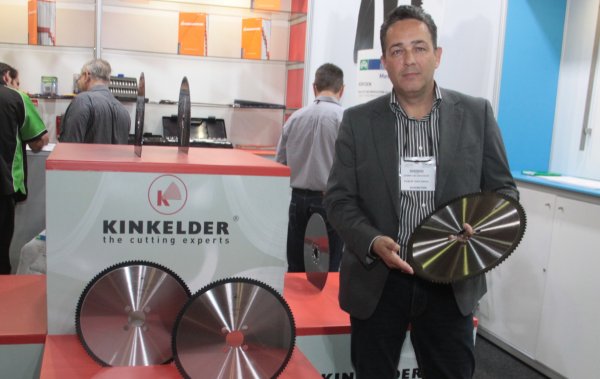Elquip Solutions and Kinkelder partner for long-term cutting-edge excellence, return-on-investment and lower cost-per-cut
Elquip Solutions and Kinkelder partner for long-term cutting-edge excellence, return-on-investment and lower cost-per-cut

Manufacturers who use large capital equipment sometimes shy away from purchasing top quality machines. The most common reason for this is the initial capital outlay. However, is this always a wise decision?
Mike Cronin, the Managing Director of Elquip Solutions, gives good reasons why it is not.
Firstly, the life-cycle costs of an inexpensive capital equipment item or consumable could be appreciably higher than those of its more expensive counterpart. One has to question: Will the cheaper machine give the same level of performance and produce the desired product quality? Will the cheaper machine be prone to more downtime and, when it needs repair, is the required aftersales support readily and speedily forthcoming?
Cronin has always believed in distributing top-quality capital equipment and consumables. “If you have capital equipment cutting steel bar, for example, you need to know the cost of each cut that the machine makes. A premium quality machine from a recognised supplier will invariably give the lowest cost-per-cut in the longer term,” he says.
Elquip Solutions therefore specialises in the supply of specialist cutting capital equipment and consumables which will truly give their users the sharpest competitive edge in the cutting of steel and other metals.
“A prime example of the kind of quality of product which we sell are the circular saw blades from our well-known Dutch principal Kinkelder, an international producer of top quality blades for the industrial and manufacturing sector,” Cronin explains.
A professional quality circular saw blade might look to the layman like a very simple device – a flat metal disc with sharp teeth on the outer rim. “However, there is definitely nothing simple about the design of a Kinkelder circular saw blade,” says Gerrit van Oosterum, Commercial Manager for Kinkelder.
He explains that significant research has been invested in Kinkelder blades, and that the manufacture of their blades is almost as much an art as it is a science. Much of the quality of Kinkelder blades lies in the years of development of tooth design and tooth spacing. In addition, there is a vast store of underlying expertise in the metallurgy of every blade.
“The key element in the specification of a saw blade is about the cutting angle, and also the tooth angles that give space to the blade after the cut. The blade must not bind in the cut otherwise excessive heat could be generated which will shorten the life of the blade,” van Oosterum advises.
Another factor is the tension of the blade body, which is very important because when a blade is in use, its operating temperature rises, which releases the tension in the blade. “If the blade loses too much tension, the blade starts oscillating sideways and cuts inaccurately, a so-called ‘side run out’.
Blade tensioning is a very precise science, which involves striking the body of the blade with a specially designed hammer. By rotating the blade and striking it at specific points on its radius, tension is built up in the blade which imparts rigidity to the disc - even under heat-inducing conditions.
It says much about the care that Kinkelder takes in the manufacture of its blades that with its top-of-the-range blades, each one is individually tensioned by a skilled craftsman. “In this age of Industry 4.0 and increasing automation, this time-honoured skill is something highly valued,” says van Oosterum.
“In addition, the tensioning process serves as a form of quality control, where human intervention serves to evaluate each blade and reject those that do not come up to standard,” he explains.
During manufacture each blade is specially coated, a factor that is of crucial importance. There are several reasons why a blade should be coated. For example, carbon-based coatings give the blade body a smooth low-friction finish; while a key quality of mainly aluminium-based coatings is to greatly reduce heat build-up in the blade.
However, despite inherent quality and many features and benefits, it is a natural tendency for buyers of circular saw blades to look for the lowest purchase price. Does buying cheap result in higher cutting costs in the long run?
Here van Oosterum gives a similar answer to Cronin. Automation is a key factor in the trend towards Industry 4.0 and the establishment of ‘smart’ factories. Automation, to be effective, has to have machines that can run unattended for long periods without unscheduled stoppages. “This is not possible with cheap circular saw blades as they need to be changed more often and someone has to be on standby as inexpensive blades tend to fail more often,” he says.
Elquip has vast experience in the marketing of Kinkelder blades as the relationship between the two companies began nearly two decades ago. “We have had a very good relationship with Mike and his team, as he is very proactive in the market and has well-trained staff assisting him. Elquip Solutions is a valued extension of our footprint in Southern Africa,” asserts van Oosterum.
“You need to be able to count on the quality of the blade to render effective cutting over a longer time span. Ultimately, the choice of a premium quality product such as Kinkelder will result in a lower cost-per-cut,” Cronin continues.
The great pride that Kinkelder has in its blades can be seen in the company’s head office in the Netherlands. Examples of gleaming blades have been beautifully framed and hang in the reception area. “Kinkelder sees these blades rather like a rock star’s gold records – every blade a hit,” he concludes.
Source: Elquip Solutions

























